Artificial Intelligence: a catalyst for entrepreneurship education in the Baltics
- DOI
- 10.5922/2079-8555-2023-3-3
- Pages
- 45-65
Abstract
The article explores the growing role of artificial intelligence (AI) in entrepreneurship education within universities. This exploration is set against the backdrop of the rapid and widespread integration of AI technologies across economic and other domains of life. The authors aim to define the concept of ‘entrepreneurial potential’ and elucidate the contribution of AI in augmenting the entrepreneurial potential among university students in the Baltic States. To achieve this goal, the authors employ a range of methods, including comparative analysis, analogy, generalization, classification, and structural-functional analysis, among others. These methodologies are integrated within an interdisciplinary framework, enabling a comprehensive investigation of the subject matter. The comparative analysis of university entrepreneurship education in the Baltic States demonstrates the strengths and weaknesses inherent in the notion of entrepreneurial potential. This study also considers the impact of academic mobility in the modern world, characterized by rapid and dynamic shifts in technology, markets, and business models. The study concludes that proficiency in working with AI-powered equipment and algorithms is of paramount importance in amplifying the entrepreneurial potential of students in Latvia, Lithuania, and Estonia. This aspect is increasingly gaining attention from universities, which collaborate closely with the business sector, governmental bodies, and regional agencies to provide diverse forms of support to aspiring business students. The final part of the article addresses issues that require more active and innovative participation of academia in activities enhancing the role of student youth in the economic development of their countries and regions.
Reference
Introduction
The aim of this article is to elucidate the significance of entrepreneurial potential within Baltic universities, utilizing a specific example, and to delineate the impact of artificial intelligence and its technologies on students’ attitudes towards entrepreneurship in these regions. This objective entails addressing the following tasks: evaluating the advantages of the entrepreneurial potential concept in studying student entrepreneurship; analyzing international experiences in assessing students’ entrepreneurial potential, particularly in light of the growing influence of artificial intelligence in various economic and societal domains; examining instances of employing artificial intelligence as a pivotal element in enhancing the entrepreneurial potential of students within the Baltic countries; and outlining future directions for investigating the entrepreneurial potential of students.
These tasks are preceded by several remarks regarding the conceptual foundations and analysis of the idea of student entrepreneurship, which express a certain interdependence between a human and a machine/algorithm as a sociocultural, socio-economic aspect of human interaction with the outside world [1, p. 6], [2]. In this regard, entrepreneurial potential, entrepreneurial talent, entrepreneurial efficiency, entrepreneurial university, and entrepreneurial thinking can be considered as different concepts for studying student entrepreneurship. Each of these concepts relates to various aspects of entrepreneurial activity and can be explored in terms of different theories and models of entrepreneurship, as well as for the analysis of data and interpretation of findings. For example, entrepreneurial talent (creative and entrepreneurial abilities) can be studied within the framework of the theory of “innovative entrepreneurship”, which focuses on the role of innovation in successful entrepreneurial activity. Entrepreneurial potential is considered using the model of the theory of planned behaviour that focuses on the planning and decision-making by the entrepreneur. Entrepreneurial efficiency is perceived through the theory of self-efficacy, which refers to how a person evaluates his/her own abilities and competencies in achieving goals.
Entrepreneurial thinking can be studied within the design thinking model, which refers to the ability to think creatively and innovatively. The concept of “entrepreneurial intentions” is related to the more general theory of entrepreneurship, which explores the process of creating and developing new enterprises. It includes aspects such as the search for opportunities, risk assessment, financial planning, resource management, etc. The ‘entrepreneurial university’ model focuses on student entrepreneurship but also covers such aspects as entrepreneurial education, support and financing of students’ entrepreneurial projects. The development of entrepreneurial thinking and behaviour can have a long-term positive effect on the future careers and life paths of student youth.
The general basis of the concepts described is made by the “theory of planned behaviour”. Its authors are Richard S. Steiner and Andrew Barto [3]. The theory of planned behaviour is also known as reinforcement learning theory [4], [5], [6], [7]. The main aspects (elements) of the theory of planned behaviour include agent (any form of artificial or natural intelligence), environment (the environment the agent interacts with, receiving rewards (reinforcements) or punishments, depending on one’s actions), environment model (agent’s internal perception of the state of the environment in response to one’s actions), reinforcement (the quantitative assessment that the agent receives from the environment in response to one’s actions), strategy (the actions of the agent in each state of the environment to achieve maximum reinforcement).
The connection between the theory of planned behaviour and the concept of entrepreneurial potential lies in the fact that both approaches are relevant to decision-making in an uncertain environment. In the context of the theory of planned behaviour and reinforcement learning, diagnosing (examination) is an important aspect, since the subject of the action must find a balance between learning new strategies and experimenting with unfamiliar actions, as well as using already familiar actions that can lead to more reinforcement.
Entrepreneurship today relies heavily on the support of cutting-edge information technologies to discover fresh ideas, innovations, and market opportunities for the development and promotion of novel products and services. Technical tools infused with elements of artificial intelligence (AI) play a pivotal role in this process. One such tool is an AI-powered chatbot known as Chat Generative Pre-Trained Transformer, or ChatGP T. These tools introduce diverse dimensions to the connection between the Theory of Planned Behavior and the concept of entrepreneurial potential.
ChatGPT, for instance, can be a valuable resource for entrepreneurs by assisting them with tasks such as generating business ideas, conducting market research, building predictive models, and identifying emerging trends. Such capabilities empower entrepreneurs to make well-informed decisions. ChatGPT and similar technical tools with AI components serve as vital support systems for young, active entrepreneurs in Latvia, Lithuania, and Estonia, furnishing them with essential information, guidance, and aid in business planning, strategizing, and decision-making rooted in the principles of the theory of planned behaviour.
However, while these contemporary tools provide invaluable support for student entrepreneurship, it is imperative to weigh the strengths and weaknesses of the entrepreneurial potential concept in light of the pervasive influence of global mobility in the modern world.
Literature review. To shift the economy from a liberal to a socially-oriented model and strive for maximum employment, both the EU countries and Russia require a strong foundation of entrepreneurial activity, particularly among the youth. Science, along with the societal demand for its accomplishments and findings, plays a vital role in facilitating this transformation. Consequently, we will analyze how the issue of utilizing AI for enhancing entrepreneurial potential is reflected in the databases of Scopus and Web of Science. In the period 2019—2023, the number of publications related to the issues of entrepreneurial potential of students using AI amounted to 25 articles published in scientific journals indexed in the Scopus scientometric database, and 62 articles — in Web of Science. According to data from the Scopus database, scholars from China exhibited the highest level of activity in research related to this topic, with 25 publications. Following closely behind were researchers from the USA, with 15 publications, and Russia, with 7 publications.
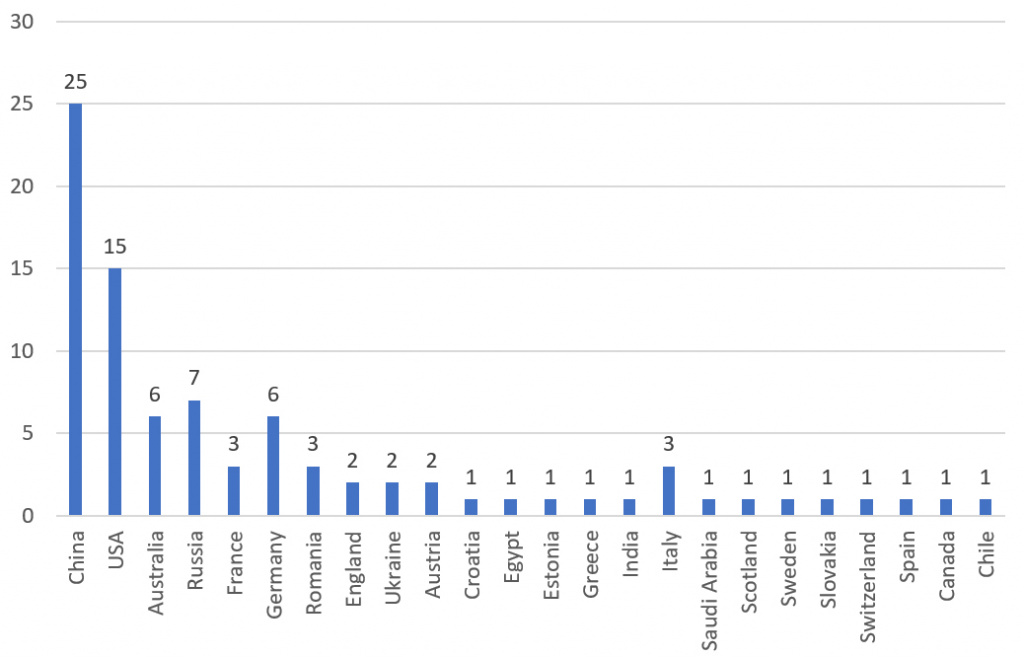
|
| 1 |
|
Number of publications in different countries containing the phrase “Entrepreneurial potential of students using artificial intelligence” in the title, abstract or keywords in the Scopus, Web of Science databases from 2019 to 2023 |
|
Source: elaborated by the authors based on the data of Scopus and Web of Science databases. |
Within the Baltic region, Estonia was the sole representative in this distribution of scientific activity pertaining to students’ entrepreneurial potential, achieving a result of “1”.
The results shown in Figure 2 confirm the interest of scientists from various fields of science in the topic of “entrepreneurial potential of students using artificial intelligence”. The majority of the publications are related to business, management, accounting, and computer science. However, 10 % of the total number of publications come from the field of social sciences.
The analysis of publications related to the issues of student entrepreneurial potential using AI revealed the fact that most often researchers cite the work by Obschonka and Audretsch “Artificial Intelligence and Big Data in Entrepreneurship: a New Era Has Begun”, published in the scientific journal Small Business Economics in 2020 [8]. The main goal of the special issue of this journal titled “Rethinking the Entrepreneurial (Research) Process: Opportunities and Challenges of Big Data and AI for Entrepreneurship Research” was to provide a multidisciplinary platform for conceptual and empirical studies dedicated to the opportunities and challenges of AI in the field of entrepreneurship research. Seven papers showing examples of case studies in this area were presented. The papers illustrate the usefulness of innovative thinking and methods, as well as the existing challenges and open questions that entrepreneurship researchers face when applying AI/Big Data to their field.
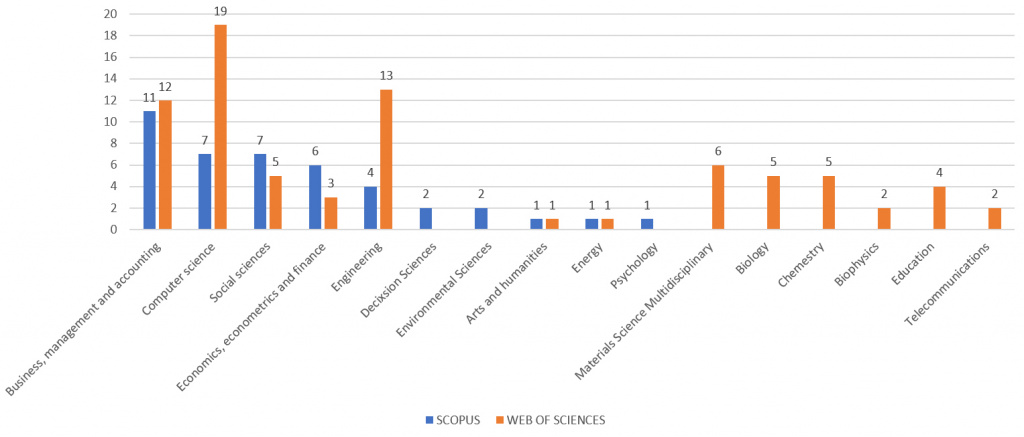
|
| 2 |
| Subject Areas in Scientific Publications (2019—2023) on Students’ Entrepreneurial Potential Utilizing Artificial Intelligence, Indexed in Scopus and Web of Science |
|
Source: elaborated by the authors based on the data of Scopus and Web of Science databases. |
The articles by Coad and Srhoy [9, p. 541—565], Obschonka et al. [10, p. 386—396], [11, p. 1—19], [12, p. 13—23], [13], [14, p. 903—927] present an empirical analysis using AI and other big data methods to test phenomena and mechanisms that have already been studied by traditional methods in previous entrepreneurship studies. The analysis conducted by Coad and Srhoy is oriented towards forecasting the parameters associated with high-growth companies. Employing the Big Data methodology, they identify authentic predictive variables from a considerably extensive pool of potential candidate predictors. In the article authored by Obschonka et al., the primary focus lies in the domain of entrepreneurship within various regions. Their objective revolves around gauging and validating disparities in entrepreneurial personality across different geographical areas. This endeavour is accomplished by harnessing vast individual-level datasets, encompassing self-reported data from several million personality assessments, and applying advanced AI techniques for analysis.
The articles by Liebregts et al. [15, p. 589—605], Zhang and Van Burgh [16, p. 607—626], the analytical report on AI by Zhang, Maslej, Brynjolfsson, Etchemendy et al. [17] present concept papers that develop theoretical thinking and knowledge about methods and data sources in the context of AI and entrepreneurship (economics). The empirical papers by Kaminski and Hopp [18, p. 627—649], Prüfer and Prüfer [19, p. 651—672], von Block et al. [20, p. 239—250] show the use of AI/Big Data methods to explore relatively new research questions. Kaminski and Hopp analyse crowdfunding campaign data (text, speech and video) using a neural network and language processing. Their analysis provides interesting findings about successful crowdfunding campaigns. Prüfer and Prüfer in their paper examine the dynamics of demand for entrepreneurial skills through the analysis of 7.7 million data collected from job vacancies. They show which entrepreneurial skills are especially important for a particular profession, and also take into account digital skills. The study by von Block et al. presents an analysis of regional entrepreneurial activity by examining the potential relationship between media and entrepreneurship from a theoretical and empirical perspective.
Various academic studies have explored the efficacy of student entrepreneurship in different nations. For instance, a 2017 study conducted by the Global Entrepreneurship Monitor (GEM)<1> underscored the substantial economic impact of student entrepreneurship in the United States. In 2016, businesses operated by students in the U.S. were responsible for the creation of a remarkable 755,000 job opportunities and made a noteworthy contribution of $ 5.2 billion to the national economy. Similarly, a 2019 research endeavour carried out in the United Kingdom illuminated the potential of student entrepreneurship in bolstering the Gross Domestic Product (GDP) and fostering job creation. Student-run businesses in the UK were found to generate approximately 5,000 job positions annually and make a significant contribution exceeding £ 100 million to the national economy. Furthermore, a 2020 study conducted in Germany demonstrated that student-led enterprises in the country played a pivotal role in generating more than 5,000 job opportunities each year, contributing approximately 250 million euros to the national economy.
These examples vividly demonstrate that student entrepreneurship can wield a significant economic impact, manifesting in the creation of new employment opportunities and substantial contributions to a country’s economy. However, it is crucial to acknowledge that the effectiveness of student entrepreneurship can vary markedly based on the country, cultural context, and a multitude of other influencing factors.
In the Baltic countries, the efficacy of student entrepreneurship has been a subject of rigorous study. Various research initiatives, such as those conducted by the Estonian Centre for Entrepreneurship Research and universities in Lithuania and Latvia, have shed light on the topic. For instance, in 2018, student-run enterprises in Estonia created over 100 jobs and contributed approximately 700 thousand euros to the national economy.
Similarly, research by the University of Lithuania in 2019 revealed that student-led businesses in Lithuania generated approximately 300 jobs annually and made a notable contribution of over 1 million euros to the country’s economy. A study conducted by the University of Latvia during the same year indicated that student-run businesses in Latvia were instrumental in creating more than 50 job positions and contributed around 100 thousand euros to the country’s economy.
One of the articles by a team of well-known Latvian economists contains data on the effectiveness of student entrepreneurship in Latvia [21]. It presents an analysis of the theme and factors contributing to the transformation of traditional universities into entrepreneurial universities in Latvia. The Latvian study narrows its focus to two key aspects: firstly, the universities’ capacity to grant students access to business incubators, and secondly, the extent to which universities are receptive to collaborating with external partners such as businesses, local municipalities, and government entities. The analysis of Latvian university-affiliated business incubators offering services to students, coupled with the examination of cooperative efforts between higher education institutions, local authorities, and entrepreneurs, reveals a discernible and favourable upward trajectory.
Noteworthy is the study of the Latvian-Portuguese research team “Comparative Analysis of Students’ Entrepreneurial Intentions in Latvia and Other CEE Countries” [22, p. 75—88]. This work is aimed at analysing the entrepreneurial behaviour and motivation of Latvian students as compared to other countries of Central and Eastern Europe. The study examines the influence of micro- and macro-level factors, as well as those of entrepreneurial education. The results revealed several statistically significant differences between students from Latvia and other countries. Latvian authors emphasise that the desire for independence is an important motivating factor, and professional education, business training and business experience are factors contributing to success in entrepreneurship. Latvian students, in contrast to their peers in other Central and Eastern European countries, perceive the regulatory framework for conducting business as a significant hindrance to entrepreneurial pursuits. Recognizing the factors that impact entrepreneurial learning, as well as the micro and macro factors influencing the career choices and intentions of young individuals, holds the potential to inform public policy enhancements within the domains of both general and vocational education. Such improvements aim to bolster the effectiveness of entrepreneurship education and promote entrepreneurship as an attractive career path.
Theory and research methods
In this study, a combination of general and specialized research methods was employed, encompassing the following approaches: historical method was utilized to examine the historical evolution of knowledge surrounding the problem under investigation; analytical-synthetic and comparative methods were applied to discern patterns and trends within the domain of media criticism by analyzing the empirical data; inductive method facilitated the generalization and systematic organization of the study’s findings. A typological analysis was used to categorize and differentiate various facets within the media criticism studies. Content Analysis was employed to delve into the specifics of the documents studied. This combination of methods allowed for a comprehensive analysis of the textual content.
Entrepreneurial potential includes several elements that determine the ability of an individual to create and develop an entrepreneurial business. Researchers have identified the fundamental components within the concept of entrepreneurial potential, which encompass:
Personal Qualities. This encompasses attributes such as creativity, motivation, persistence, determination, risk tolerance, and others.
Entrepreneurial Knowledge and Skills. Proficiency in the knowledge and skills requisite for launching and managing an entrepreneurial enterprise, encompassing managerial expertise, market acumen, financial planning, and more.
Entrepreneurial Experience. Practical involvement in real-world scenarios and the decisions made therein.
Social Environment. This pertains to the milieu in which an entrepreneur grows and resides, including family and professional support systems, as well as access to resources and networks, all of which can bolster entrepreneurial potential.
Entrepreneurial Environment. The broader economic and political context within which entrepreneurial ventures operate, encompassing market viability, access to capital, and infrastructure, all of which can influence the attractiveness of entrepreneurship.
Each of these facets exerts a substantial impact on entrepreneurial potential and the eventual success of entrepreneurial enterprises.
In recent decades, the concept of ‘mobility’ has emerged as a significant element within the framework of entrepreneurial potential, particularly in the contemporary world marked by the Internet, social networks, and economic globalization. Entrepreneurs now have the capability to operate remotely, traverse the globe, and explore new markets, products, and services using the internet and information technologies. This universal mobility allows entrepreneurs to remain in a perpetual state of flux, swiftly adapting to evolving circumstances. Entrepreneurs who have gained experience in diverse cultures and geographic regions often possess a broader perspective and a deeper understanding of cross-cultural distinctions, which proves invaluable for business expansion. Hence, universal mobility can and should be recognized as a pivotal component of entrepreneurial potential in today’s dynamic world characterized by rapid changes in technologies, markets, and business paradigms.
One of the first scholars who drew attention to the importance of mobility in the structure of entrepreneurial potential was McClelland [23]. For an entrepreneur, a new understanding and measurement of mobility becomes the most significant condition for success [24, p. 236—245]. In 2020, the analysis of the entrepreneurial potential of Latvian students with the inclusion of mobility in its structure was presented in the article by Latvian scientists [25, p. 70—80].
The participation of Baltic students in entrepreneurship has both positive and negative aspects for their professional activities and the societies in general. The following positive aspects may be distinguished:
Economic Development: student start-ups have the potential to create new employment opportunities and contribute to increased economic development.
Skill Enhancement: participation in student entrepreneurship cultivates valuable skills like leadership, effective communication, and adept time and resource management.
Innovation: students engaged in entrepreneurship often generate and implement innovative ideas, fostering progress and innovation.
Boosted self-esteem: success in student entrepreneurship can bolster participants’ self-esteem and confidence in their capabilities.
However, it’s essential to acknowledge the potential drawbacks:
Risk of failure: student start-ups, like any entrepreneurial venture, carry the risk of failure, potentially resulting in the loss of participants’ time and resources.
Distraction from studies: involvement in student entrepreneurship may divert students’ attention from their studies, leading to lower academic performance and graduation delays.
Lack of support: some educational institutions and faculty members may not fully endorse student entrepreneurship due to concerns about its impact on academic standards or study distraction. Nevertheless, a growing number of universities and colleges recognize the value of entrepreneurship in education, offering resources and infrastructure to support student entrepreneurial endeavours.
Discussion and study findings
AI as a means of enhancing the entrepreneurial potential of students (international research experience). Technical tools with elements of artificial intelligence significantly increase production efficiency, freeing workers from routine and heavy operations. Figure 3 shows how many workers were needed between 1990 and 2020 in large companies to get an income of 1 million US dollars. In 2020, after the advent of AI, companies only needed 2 employees to generate $ 1 million in revenue.
The use of technical tools with AI elements can significantly increase the opportunities and entrepreneurial potential of students. One of the most notable opportunities is the increase in the efficiency of business processes. With the help of AI, one can automate many routine tasks, such as data analysis, document processing, and more. This allows students to focus on more important tasks such as developing strategies and solving complex problems.
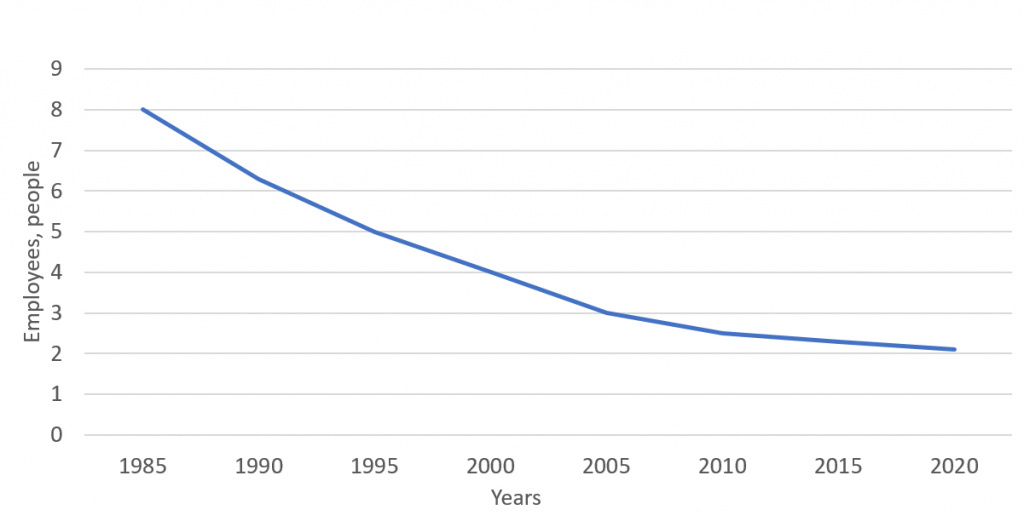
|
| 3 |
| Employees needed at S&P 500 companies to generate $ 1 million in revenue in 1990—2020 |
|
Source: Workers needed at S&P 500 companies to generate $ 1 million in revenue, courtesy of Semafor, 2023, Reddit, URL: https://www.reddit.com/r/neoliberal/comments/10qfpvg/workers_needed_at_sp_500_companies_to_generate_... (accessed 08.06.2023). |
Another possibility is to increase the prediction accuracy. AI can analyse vast amounts of data and identify trends and patterns, allowing students to make better decisions and make more accurate predictions. Using AI-powered machines can help students find new business opportunities and create innovative products. Machine learning algorithms play a crucial role in identifying emerging trends and unmet market needs, thereby empowering students to develop products that align with current demand. The use of robotics and AI systems can greatly accelerate the development and production of products, which allows one to start business more quickly and make a profit. As a result, the use of technical tools with AI elements can increase the efficiency, accuracy, innovativeness and speed of business processes, which greatly enhances the entrepreneurial potential of students.
AI can be used to automate risk assessment, market analysis, and business idea potential. This will allow students to receive more accurate and objective information about the market and the risks associated with starting a business. AI can also be used to personalise entrepreneurial learning. Machine learning algorithms can analyse student learning and preference data and create customised learning plans that are tailored to each student. Finally, the use of robotics and AI systems can help students prototype and test their products, allowing them to develop and launch their business faster and at a lower cost.
In the virtual environment, there are already quite a lot of examples of projects using AI in the field of entrepreneurial education and information about their developers. Among them is ELSA (English Language Speech Assistant) — an application for learning English using speech recognition and machine learning technologies.<2> Carnegie Mellon University employs AI technology to assess students’ business plans. Ametros Learning utilizes AI to tailor student learning experiences in the field of business. Stratifyd offers a data analysis platform that harnesses AI for automated data categorization and visualization through graphs and charts. Riid is a platform that harnesses AI to craft customized educational materials and assessments for students studying business and economics. Knewton is another platform leveraging AI to dynamically personalize student learning in real-time. Cognii uses AI to develop interactive courses and automatically assess assignments and tests. Coursera, an online learning platform, employs AI to personalize the learning journey and automate the grading of assignments. Duolingo, a language-learning platform, employs AI to customize learning experiences and grade assignments. Udacity, an online course platform, uses AI to generate personalized learning materials and automate assignment grading.
Numerous startups and companies have been founded by students and young entrepreneurs, leveraging AI technologies for innovative solutions. Among the most notable success stories in this domain are:
Grammarly: An online service that employs AI technology to check and improve grammar and spelling in texts.
UiPath: A company specializing in the development of software for automating business processes through robotic process automation (RPA).
DataRobot: A platform that harnesses machine learning and AI to analyze data and construct predictive models for business applications.
Zest AI: A company focused on automating lending processes using AI-driven tools.
DeepMind: A pioneering company in AI and machine learning, dedicated to developing algorithms that address complex challenges, particularly in healthcare and scientific fields.
These examples represent just a fraction of the successful startups and companies that employ AI technologies. Every year, new and innovative projects continue to emerge worldwide, with students actively contributing to the creation of fresh ideas and the development of groundbreaking technologies. Thus, technical tools with AI elements can be useful for entrepreneurship education, especially in the field of creating virtual business simulations, automating risk assessment processes and personalising learning.
One of the leaders of Microsoft, Jean-Philippe Courtois, in his review “How AI is transforming education and skills development” describes in sufficient detail the possibilities of new digital technologies in education.<3> Australian professor Kellermann demonstrated a new digital assistant “Beacon”, recently launched by Staffordshire University in England. Its purpose is to alleviate the stress and anxiety that many students experience in their first year at university. Beacon is powered by the Microsoft Azure cloud computing platform and capitalises on the fact that students at Staffordshire University, a leader in introducing digital technologies, are more likely to turn to their mobile phone for information and help than to university faculty and staff.<4>
In addition to being used in traditional schools, AI can also help people retrain and acquire new skills. This is made possible by Microsoft’s partnership with Ashoka, a global organisation that supports social entrepreneurs who seek innovative solutions to the most pressing social, cultural and environmental challenges. The new partnership is based on the Microsoft-Ashoka Accelerator programme, designed to develop an ecosystem of start-ups that use the power of cloud computing and artificial intelligence to solve social and environmental problems. Ashoka pays special attention to programmes for youth, recognising the benefits of helping a new generation of young entrepreneurs gain the confidence, skills and knowledge they need to apply advanced technologies in innovative social projects. Through its Youth Ventures Ashoka programme, Ashoka partners with over 500,000 young people around the world.
Achieved investment in global AI start-ups amounted in total to $93.5 billion in 2021, more than double the investment of 2020.<5> The largest companies and countries in the world are competing for leadership in AI. Sundar Pichai, CEO of Google, said in 2016: “In the next 10 years, we will shift to a world that is AI-first.” For example, across all US sectors for which data is available (excluding agriculture, forestry, fishing, and hunting), AI-related job postings increased on average from 1.7 % in 2021 to 1.9 % in 2022. Employers in the United States are increasingly looking for university graduates with AI-related skills.
There are numerous studies on the creation of artificial intelligence, a lot of research on human biological processes that conditionally control our natural intelligence. But how they interact with each other and what the specifics, price, losses, benefits from this interaction are, is much less clear [26]. It is estimated that half of today’s students will work in professions that do not yet exist. A country and society that can develop better AI systems and use the existing ones will have a great development advantage over those countries that have not developed and implemented AI systems.<6> The lag in the development of AI will mean a significant lag in the entire economy of the country.<7>
Artificial intelligence stands as one of the pivotal factors and essential tools in bolstering the entrepreneurial potential of students across the Baltic countries. AI in secondary and vocational education is an important area of development in many countries, including the Baltic countries. In these countries, there are several initiative projects aimed at the use of artificial intelligence in education. In Estonia, for example, the Estonian Education Nation (Estonian National Education Initiative) launched the Education Nation AI project (National Educational AI Initiative), which aims at using artificial intelligence to improve education. The initiative aims to develop a comprehensive AI education programme for students of all ages, from elementary school to higher education. In addition, this project is aimed at developing expertise in the field of AI and its application in education. For this, special research groups have been created to study and analyse existing technologies, develop new methods for using artificial intelligence in education. In general, the Education Nation AI project is an important step towards the development of the use of artificial intelligence in education, and can become an example for other countries that also seek to improve the quality of their education with the help of modern technologies.<8>
In Lithuania, there is an initiative project AI-Schools,<9> which aims to increase the level of knowledge of teachers and students in the field of AI. The project provides learning tools and materials, including online courses and guidelines. As part of the AI-Schools Project, students can study various aspects of AI, such as machine learning, natural language processing, computer vision, etc. They can also participate in competitions and projects related to the use of AI in various fields, such as medicine, transport, finance, etc. The goal of the AI-Schools project is to make AI learning accessible to all students, regardless of their age and level of knowledge in this area. It also aims to develop students’ critical thinking and problem-solving abilities and help them recognise the potential and limitations of artificial intelligence.
In Latvia, the AI-Schools Project is implemented jointly with Microsoft, which provides technical support and cloud resources for training artificial intelligence. There are also other programmes in Latvia aimed at developing information technology skills among pupils and students. One of these programmes is the national initiative Digilab, which has been operating since 2018 and is aimed at improving the digital literacy of schoolchildren and students aged 7 to 25 years.<10> There are other educational centres in Latvia that provide courses on various aspects of working with information technology. For example, the company Riga TechGirls organises courses and events for girls and women who are interested in technology and programming. Many universities and colleges in Latvia offer courses and programmes in information technology, including programming, databases, website development and other topics. These programmes are designed for students of various specialties and levels of training, including Bachelor’s, Master’s and Doctoral study programmes.
Some Latvian universities offer programmes that use artificial intelligence directly to develop the entrepreneurial potential of students. Riga Technical University implements master’s programmes such as Computer Vision and Artificial Intelligence and Artificial Intelligence and Machine Learning, which are designed to train specialists in the field of artificial intelligence and its application in various industries, including entrepreneurship. Latvia University of Life Sciences and Technology offers master’s programmes Artificial Intelligence and Machine Learning and Data Mining, which are designed to educate students in the field of artificial intelligence and its application in various fields, including entrepreneurship. The University of Latvia has a Department of Computer Science and Mathematics offering a master’s programme Computer Science, which includes the study of artificial intelligence and its application in various industries, including entrepreneurship.
The first virtual assistant Una will celebrate this year its 5th anniversary of work in the Register of Enterprises (RE) of Latvia. Una has mastered many areas of RE activity and has learned to answer thousands of different questions about the creation, management and liquidation of companies in Latvian and English. The situation is more complicated in the private sector, where Latvia lags behind its neighbours Estonia and Finland, as well as the Scandinavian countries in the implementation and use of virtual assistants. Active and skilled youth, living in an environment of economic innovation, are becoming more demanding of product sellers and service providers, and will gradually force existing and new businesses to overcome the barrier of distrust, skepticism and fear, starting modern communication with their customers through virtual employees.<11>
AI has emerged as one of the most promising and disruptive general-purpose technologies (GPT) with the potential to change every aspect of our lives and drive economic growth. The most popular 2022 Google search topics in the Baltics were ‘marketing’, ‘artificial intelligence’, ‘computer programming’, ‘Internet bot’, ‘machine learning.<12>
According to the data from the OECD Observatory of Artificial Intelligence Policy spanning the years 2000 to 2022, it is evident that AI research and subsequent publications are predominantly conducted by certain institutions in the Baltic countries. In Latvia, noteworthy contributors include Riga Technical University, the University of Latvia, and Riga College of Business Administration. In Estonia, key players in AI research are Tallinn University of Technology, the University of Tartu, and Tallinn University. Lithuania boasts active AI research conducted primarily by Vilnius Gediminas Technical University, Kaunas University of Technology, and Vilnius University (Fig. 4).
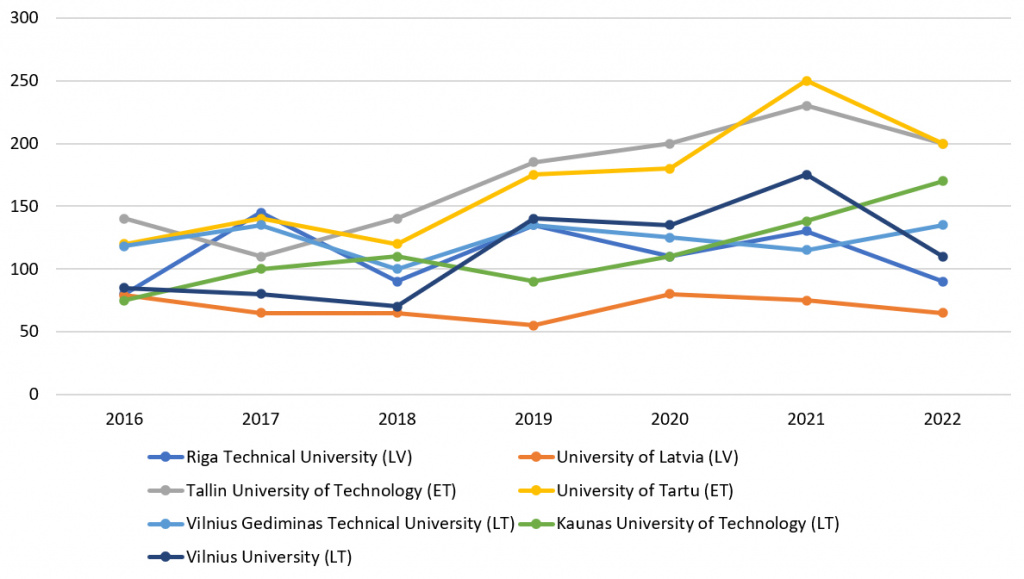
|
| 4 |
| Research on AI in higher education institutions in the Baltic States, number of publications |
|
Source: elaborated by the authors based on the data of ORCD.AI.<13> |
Regarding the concentration of AI talent, which refers to the percentage of LinkedIn members possessing AI skills or being engaged in AI-related activities, it is noteworthy that in 2022, this percentage closely aligns between Lithuania and Estonia, both standing at 24 %. In Latvia, while still significant, this percentage slightly lags behind at 18 % (Fig. 5).
The data of Studyportals help identify national and international AI learning trends and assess educational resources and needs against national goals. Comparing AI-enabled education data across countries provides valuable information to inform education and labour market strategies and policies. In 2022, 37 % of AI courses were offered in the US, 24 % in the UK, and 18 % in the 27 countries of the European Union including in the Baltic States — 0.1 % – 0.3 %.<15>
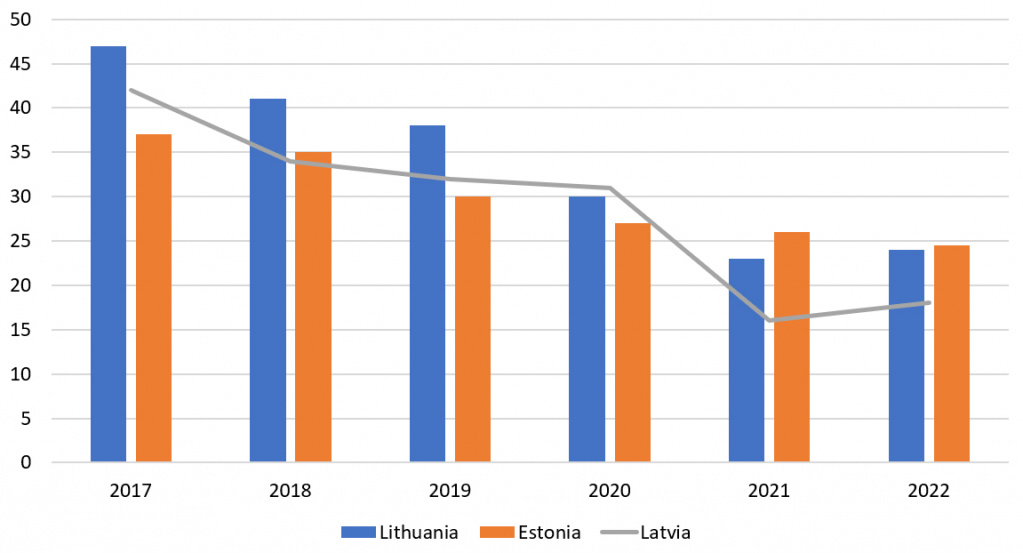
|
| 5 |
| Concentration of AI talent across the Baltics, % of LinkedIn members with AI skills or doing AI |
|
Source: elaborated by the authors based on the data of OECD.AI.<15> |
Analyzing AI courses by discipline, it becomes evident that the majority of these courses are conducted within the subject area of Computer Science and Information Technology (100 %). Additionally, AI courses are offered to a lesser extent in disciplines such as Business and Management (19 %), Natural Sciences and Mathematics (18 %), Engineering and Technology (11 %), and Social Sciences (4 %). When it comes to AI courses available in English for students within the EU, specifically in the Baltic countries, the percentage of these courses falls within the range of 0.6 % to 1.54 % as of the year 2022 (Fig. 6).
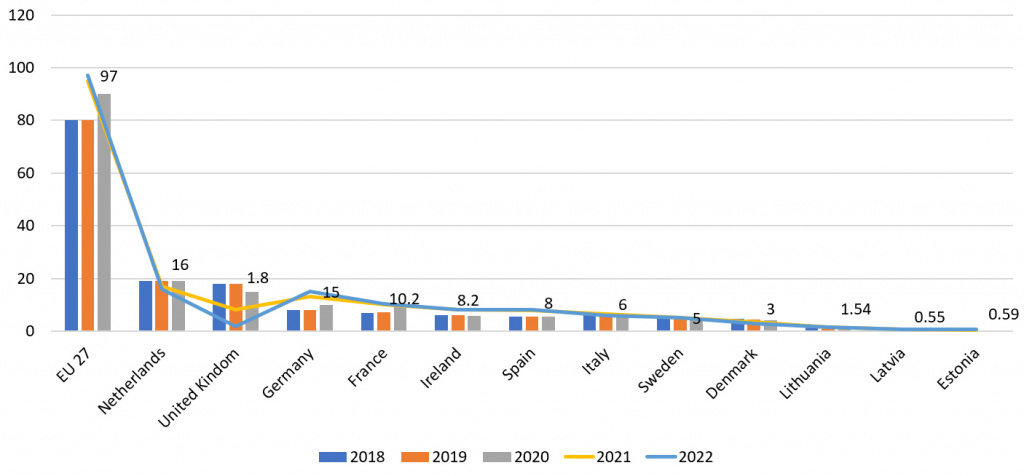
|
| 6 |
| AI courses in English in EU countries, by target audience, % of the total number of AI courses |
|
Source: elaborated by the authors based on the data of OECD.AI.<16> |
For net migration flows of AI-skilled LinkedIn members (LinkedIn is an international social network for finding jobs and employees, exchanging experience and establishing business ties) from 2019 to 2022, see Figure 7.
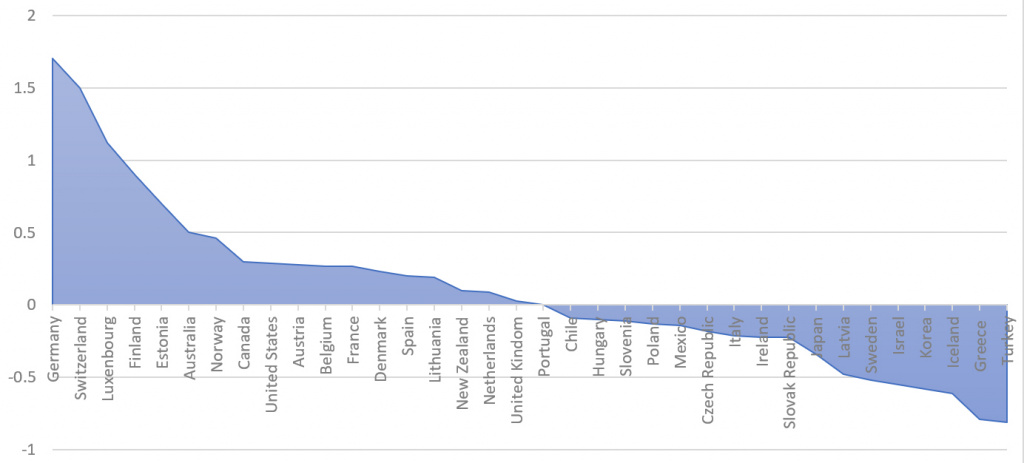
|
| 7 |
|
Net migration of LinkedIn members between countries with AI skills, 2019—2022, % per 10,000 LinkedIn members
|
|
Source: elaborated by the authors based on the data of OECD.AI.<17> |
The dynamics depicted by the blue background of the columns illustrate the fluctuations in the number of LinkedIn members with AI skills across different countries. Estonia and Lithuania show a positive trend with an increase of 0.76 % and 0.18 %, respectively. Conversely, Latvia experiences a decrease, with a loss of 0.27 % of such participants.
Conclusions
The study conducted shows that the use of machines/algorithms with AI elements introduces significant changes in the economy, social sphere, science and education. An increasing number of universities and colleges in the EU and other countries are realising the importance of entrepreneurship in education and supporting students in their start-ups by providing resources and infrastructure for the development of entrepreneurship. The findings of international studies indicate an increasing interest in the topic of student entrepreneurship and the use of AI to nurture this potential. This trend is not unique to global research but is also evident in Latvia, Lithuania, and Estonia. These countries are witnessing significant advancements in employing AI to boost the entrepreneurial abilities of students. This development is crucial, especially considering the significant changes occurring in higher education. Universities now possess ample resources and opportunities to enhance the entrepreneurial potential of students who have a strong interest in entrepreneurship.
AI technologies have become one of the most promising and disruptive general-purpose technologies (GPT) with the potential to change many aspects of modern society and stimulate its economic development. The study’s findings affirm that various initiatives are actively underway in Latvia, Lithuania, and Estonia to integrate AI into both general and vocational education across different educational levels. These initiatives are instrumental in bolstering the entrepreneurial potential of students in the Baltic countries. For example, Latvian universities offer Master’s programs such as Artificial Intelligence and Machine Learning and Machine Learning and Data Mining, with similar programmes available in other Baltic nations.
Interestingly, a glimpse into the 2022 Google search trends in the Baltics reveals that topics like ‘marketing’, ‘business and management’, ‘artificial intelligence’, computer programming’, ‘Internet bots’, and ‘machine learning’ stirred considerable interest. Conversely, the English language was of lesser interest, likely because the majority of active youth already possess proficiency in it. The participation of students from the Baltic States in entrepreneurship has positive (development of professional business skills; innovative development of activity; growth of self-esteem; creation of new jobs, etc.) and negative (risks of failure and loss of time and resources; distraction from studies; lack of external support, etc.) aspects for their professional activity and the development of societies in general. At the same time, the results of the work showed that in the Baltic countries, the scientific research in the field of entrepreneurial potential of students is not only differentiated, but also underdeveloped: only Estonia still corresponds to the pan-European level of research activity in this area. The activity of student entrepreneurship in the Baltic countries, in practical terms, is also varied. The most successful activity of student enterprises using AI is represented in Lithuania, where they create about 300 new jobs annually and already contribute more than 1 million euros to the country’s economy. In Estonia (2018) and Latvia (2019), respectively, 100 jobs and 700 thousand euros; 50 jobs and 100 thousand euros.
The analysis of the international experience of studying the entrepreneurial potential of students in the context of an increasing role of AI in the economy and other areas of life shows that student entrepreneurship in the USA and certain EU countries using AI has a higher economic efficiency: it creates tens and hundreds of thousands of jobs and invests millions and billions of funds into the economy. Therefore, assessing student entrepreneurship and its potential in the Baltic States, it can be argued that it has great opportunities for growth and development, taking into account the experience and various economic (resource) and non-economic (socio-cultural) factors.
The activity of participants in LinkedIn, an international social network for finding jobs and employees, exchanging experience and establishing business connections with those possessing AI skills or doing AI, also varies in the Baltic countries. In Lithuania and Estonia, the number of such participants in 2022 was almost the same and amounted to 24 %, in Latvia it was slightly lower and amounted to 18 %.
Universities in the Baltic States have their own track record of boosting student entrepreneurial potential using advances in AI. Summarising the results obtained to identify further directions in the study of the entrepreneurial potential of students in Latvia, Lithuania and Estonia, the following can be stated. The expansion of this potential depends on existing and emerging new research teams in universities working on AI issues, and its containment depends on insufficient funding from European and national programmes and projects for researching AI. A positive decision of all stakeholders (businesses, universities, the state) on increasing funding for research teams studying AI issues would contribute to the expansion and growth of universities in the Baltic countries, which significantly increase the entrepreneurial potential of their students in scientific and practical aspects.